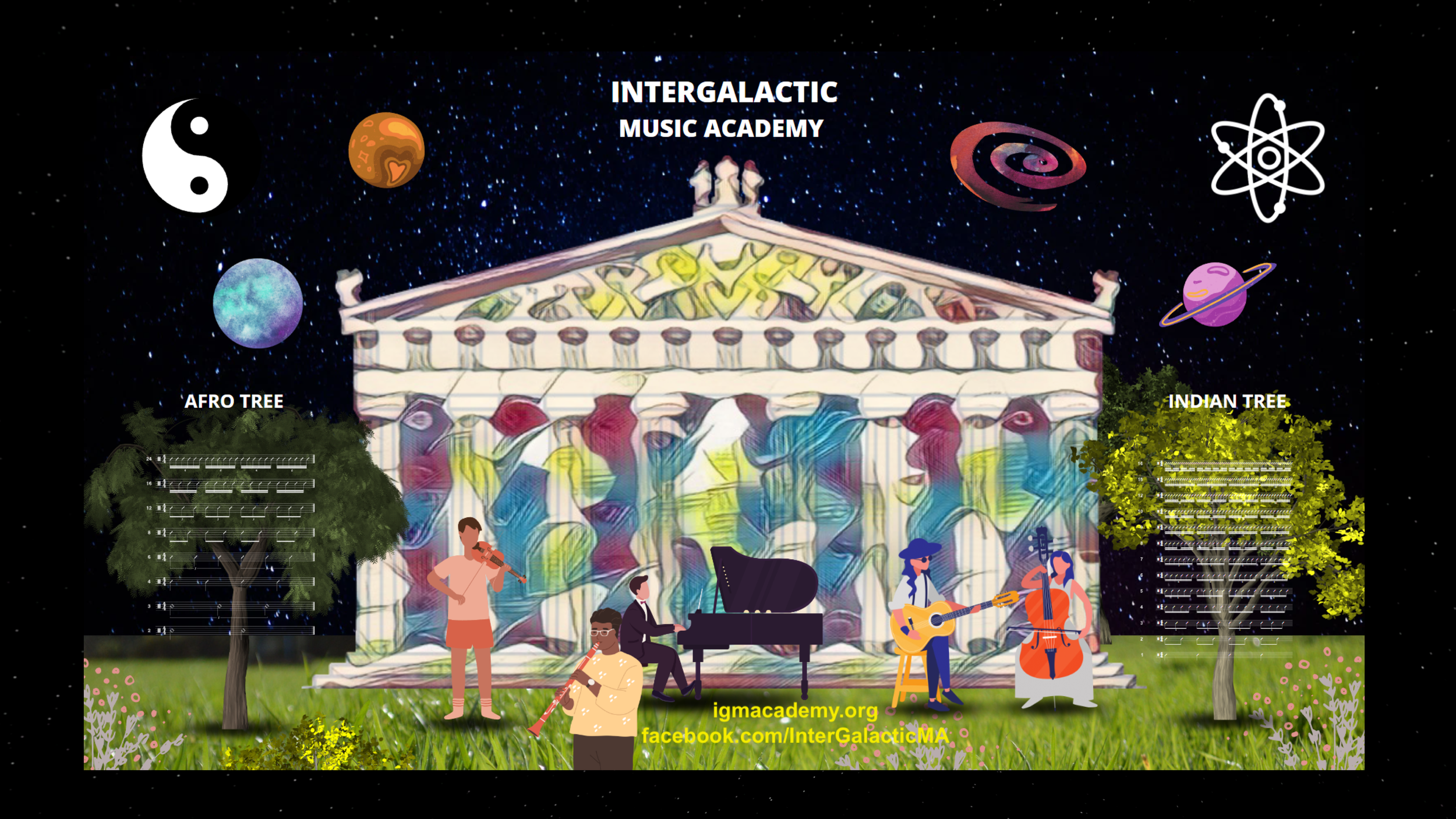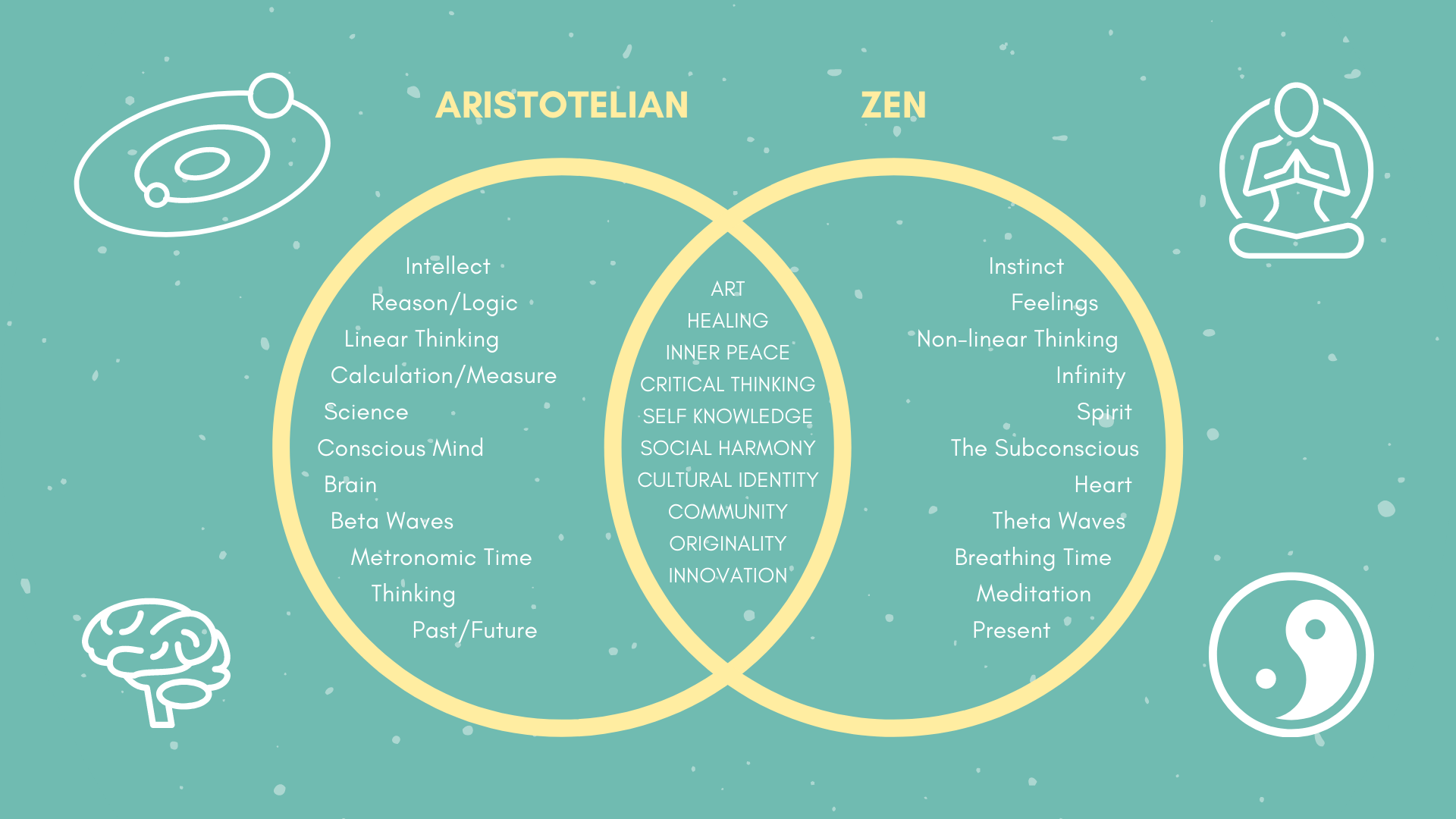Discover & Unlock Your Personal Musical Voice And Become the Creator of the Next “New Thing”
Dive into an holistic music training based on Ear, Rhythm, Composition, Improvisation, Reharm, Repertoire, and Instrumental Technique through imagery, games and cross-disciplinary arts

Cultivate a balance between your body, mind and soul
In the Intergalactic Music Academy, we utilize colors, geometry, movies, poetry, paintings, Tai-Chi/ Qigong, and other art forms in order to help students to tap into their Body & Soul (Zen) and The Intellect (Aristotelian), and transform their Ear, Rhythm, and Technical skills.
Students arrive at the desired level through project-based education, which includes film-scoring projects, reharmonization of existing melodies, improvisation, and composition; a teaching approach customized to each individual’s needs and wishes as they evolve in their musical pathway.
Every subject is approached from the “Universal Oneness” standpoint. There are no dissonant sonorities or dissonant chords or "avoid notes," but rather Rainbows: A Diverse and Infinite Spectrum of Bright, Dark, Cool, and Warm Colors. A multicolored universe in which we celebrate equality and each other’s culture and uniqueness.

Courses
In the Intergalactic Music Academy, we offer courses that are creative, joyful, and effective. These courses have been taught to hundreds of students from all parts of the world since 2005, when Lefteris Kordis began his teaching career as an adjunct professor at the New England Conservatory and later on at Berklee College of Music to this day. Lefteris designs and develops his courses from a holistic perspective by creating a fine balance between the intellectual (Aristotelian) and the instinctual (Zen). His main goal and desire has been to make music learning a creative, fun, liberating, and healing journey for his students and himself. As he puts it in his own words: “I aspired to become the teacher I always wanted to have.”
Intergalactic Harmony
The Intergalactic Harmony concept is a multi-dimensional system of Functional, Non-Functional, Atonal and Microtonal Harmony applied on Improvisation, Composition, and Ear Training.
We utilize the universe as an abstract springboard to create an interactive circuit from the macro- (atonal) to the micro- (functional) levels. Like the real universe, we navigate in a dimensional/quantum manner. The universe represents all frequencies and all sound configurations, which are infinite. In this concept they are systematically organized as sound colors in the form of galaxies, parent solar systems, solar systems, planets, continents. and regions.
Inspired by Lefteris’s teachers Herb Pomeroy, Steve Lacy, Charlie Banacos, and George Russell.
Rhythm Trees
Rhythm training using brain and body. Afro, Indian and Swing Trees in conjunction with Rhythm flash cards and dance (kinesthetics).
The Trees work in conjunction with Banacos’ idea of using Rhythm flash cards, and some basic kinesthetics concepts that I learned from my experience playing in Greek folk dance Festivals for many years, as well as through my studies with percussionist Jerry Leake. The main point is to teach rhythm in a holistic way by engaging the body, the intellect, and the instinct. Regarding the body, students are instructed to tap rhythms and strengthen the 2nd chakra, stomp, and speak rhythms before playing them on the instrument.
Also, we use rhythmic modules as building blocks (legos) to create new and original patterns and new musical works. This course helps students to assimilate rhythms in a natural and profound way which will allow them to be able to transcribe as well as to perform rhythms.
Inspired by Jerry Leake, Charlie Banacos, and Body & Brain Yoga, Tai Chi, and Qigong.
Harmakam
Harmakam is an equilibrium between Equal tempered Harmony and East Mediterranean microtonal Folk melodies and Improvisations. Ear training, and project-based curriculum that includes Reharmonization, Improvisation and Composition projects.
In this course, we utilize the Intergalactic Harmony concept and create a close circuit between the Western European Equal-Tempered Theory and Practice and that of Eastern Mediterranean Modal (Microtonal) theory and practice. The point of departure is the repertoire of East Mediterranean folk music as well as the music theory from the Pythagorians, Byzantine echoi (sounds in Greek), Turkish makam, and Arabic maqam. In Harmakam, we create new diatonic harmonic environments by following a procrustean method to use equal tempered harmonic colors under micro-tonal melodies and improvisations (taxim or verso). This process led me to discover harmonic colors (chords), voicings, and harmonic movements, which are fresh, unique, and beautiful. The Harmakam course includes: Ear training, Improvisation, reharmonization of existing folk melodies, composition projects with unusual harmonies that operate far beyond the borders of functional harmony. Students have mentioned that this course expanded their harmonic, compositional and ear skills, while they developed an appreciation for the music traditions of the East Mediterranean paradise.
Inspired by Lefteris’s performances with Mikis Theodorakis, Vasilis Saleas, Lefteris Bournias, Panayotis Lalezas
Instrumental Technique/ Physiology
For piano technique/physiology, I am teaching an approach that is a synthesis of tools and concepts that I learned through Charlie Banacos, Eva Stange (student of Paul Badura Skoda), books by Abby Whiteside, Dorothy Taubman, and Tai Chi and Qigong. Since 2017, I have been practicing Body & Brain Yoga which is based on Sundo, an ancient Korean Taoist practice that includes Tai Chi, Qigong, Yoga, Meditation. These practices, help students to experience a tremendous sense of effortlessness, physical and spiritual performance power, and longevity in practice (hours of practice without getting tired). The main objectives are to achieve enormous speed and effortless, expressive playing, strengthen the 2nd and 3rd chakras, use chest and upper arm muscles and send the energy flow through the body joints (levers), minimal use of finger movement, and use gravity and circular motions, while maintaining proper posture (straight back, proper bench height, vertical and horizontal alignment).
Inspired by Banacos, Eva Stange (Skoda), Whiteside, Taubman, and Body & Brain Yoga, Tai Chi, Qigong.
7 Steps to Eden: The Art of Transcription
7 Steps to attain a holistic sense of a musical composition, a song, or an improvised solo. Activities include singing, playing, notating, graph scores, analysis, model improv / composition, and historical, socio-political context.
Inspired by Allan Chase, Lennie Tristano, Ran Blake, and Folk musicians who learn and teach music by ear.
One Chord Journey
In this course, we explore more than 48 single chord qualities ranging from triads to 13th (Galaxy 7) and up to 23rd chords (Galaxy 12). We navigate in 4 stages: Ear Training, composition, improvisation, and film-scoring. The Intergalactic Harmony concept is the main tool in this course.
Inspired by Maurice Ravel, Charlie Banacos, and Herb Pomeroy
One Note Journey
Different faces of one note under endless combinations of non-functional chord progressions. We follow a wide range of pathways from a highly structured method to aleatoric activities that include use games with flash cards of keys and chord qualities. In creating this course, I was inspired by A.C. Jobim’s “One Note Samba” and John Lennon’s “Julia” as well as conversations with Charlie Banacos and Scott deOgburn. The Intergalactic Harmony concept is the main tool in this course.
Inspired by Charlie Banacos and Scott deOgburn, A.C. Jobim’s “Samba de uma nota” and John Lennon’s “Julia”
Shades of Outness
Course for composers and jazz improvisers that offers a vast collection of melodic cells and chordal structures that transform the linear subdominant-dominant-tonic functionality into dynamic, non-linear and spatial constructions. The Intergalactic Harmony concept is the main tool in this course.
Inspired by Lennie Tristano and Allen Forte’s Pitch Class Set Theory
Other courses
The Post Bebop Era (1949-1961)
Music of Greece: From Homer to Xenakis
Ear Training for the World Musician
Text painting in Byzantine Hymns
Jazz Improvisation History, Analysis, and Performance
Testimonials
“A kind and altruistic person [...] articulate, extremely well organized, very clever on technology. He can grasp the soul of a piece with a wonderful appreciation for stylistic originality. ”
“Lefteris has been an incredible teacher for the past six months, and I can say for certain I have learnt more than in the past five years before. He offers a personalized teaching approach with a focus on allowing the student to find their own solutions - and he is never short for suggestions. The skills I have gained will serve me well in any kind of musical situation I happen to find myself in, and I count myself very lucky to be able to be a student of his (hopefully for a long time to come!).”
“A remarkable hardworking teacher and creative jazz pianist and composer. I am most impressed with the detailed and patient way he can break down and clearly explain the mechanics of what and why we are working this way.”
“Lefteris offers students a vast pool of experience and knowledge that one can dip into - it’s actually more like you want to jump in and splash around when you realize what he has to offer! His enthusiasm and love for music creates an atmosphere of positive vibes and a safe space for learning. With patience, encouragement and true commitment, he will leave no stone unturned in helping a student understand a topic.”
“An encouraging and open minded teacher, which is rare. I would like to work with him forever and ever ”
“Like many other musicians, I always had trouble identifying the fine details of exactly what was happening in the music I played. I could feel dense harmonies and chord progressions, but for the most part I couldn’t readily identify them. Within just a few months of studying theory and ear training with Lefteris, this has begun to change radically. It’s as if a dense fog had always been obscuring the connection between my inner ear and my conscious mind, and with Lefteris’ guidance I’m finding my way out of the fog into a bright clearing, full of birds and fragrant blossoms. What impresses me the most about Lefteris is not his impeccable musicianship or his firm command of an unusually wide range of musics, though these are apparent to anyone who spends any time at all around him. What makes him such an extraordinary teacher is his very obvious commitment to bringing out the absolute best in his students by patiently, compassionately, and methodically training us to let our intuition take the lead in what we do as musicians. In the short time that I’ve been studying with him, I’ve experienced a dramatic improvement in my comprehension of harmonic progressions and an explosion of compositional creativity. I can’t recommend him highly enough.”
“I feel extremely fortunate to have found Lefteris as my teacher. Being a teacher of classical piano myself, I know what it takes to teach- -and am happy to say that he is everything you would want to find in your dream teacher- - brilliant, organized, inspiring, and deeply tuned to the needs of the student. Every lesson is custom tailored to each student, and he was able to assess exactly what I needed to begin my journey as a beginning jazz student.
I am so happy with the progress that I have made, and can’t wait for my next lesson!!”
Transcriptions
Cross-disciplinary Ensembles
The following videos feature Lefteris’s cross-disciplinary work with ensembles at Berklee Global Jazz Institute from 2017-2019, showcasing his arrangements, coaching, original ideas, and in some cases composed sections.
Schedule a free 30 minute lesson
Contact
For inquiries please contact us at
Email
leftchordmusic@gmail.com
Phone
+1 (617) 840 9140
